Costume Making or Serendipity

We don't wear any special clothing for our weekly meetings, although comfortable shoes are important, but costumes add sparkle to occasions such as
displays, and Playford or Regency Balls. My own costume was made with purchased fabric and the Butterick 'Making History' pattern 3640.
The costume on the left is one of the early costumes I made for my local International folk dance group B.R.I.D.E. for their English Dance display at the
Llangollen Eisteddfod; it was cobbled together from old curtains and pink sheets. The Simplicity children pattern 3725 was used as a guide but with hooks and
eyes for front opening rather than a zip at the back.click for BRIDE English costume page
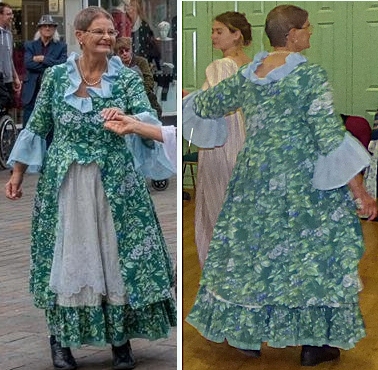
Whilst trying to achieve authentic looking replicas of historic costume I tried using different patterns. This is Playford style costume based on the
Butterick 'Making History' pattern 3071 which has the skirt and bodice as two separate garments with a backzip; but zips didn't fit well with my notions
of authenticity so again I used hooks for a front opening overdress; and I joined the overskirt to the bodice, with a separate under skirt.
The fabric
was gleaned from the local scouts jumble sales, in the form of curtains and net curtains. At one stage a spare room was filled with piles of curtains of
which there seemed to be an endless supply, the reason being that curtains were going out of fashion and blinds were coming in.
18th & 19th Century fashion decreed very low necklines, but these are not always welcomed by 20th & 21st
Century ladies. The finished costumes often deviate from the pattern to accomodate this and other factors.
Another reason being I must cut the coat to fit
the cloth. The available fabric (curtains) was not always enough for what the pattern demanded, so every frock is unique, some skirts are fuller than others.
The costume to the right (curtains again) also has a pretty pink lace apron and flounces on the sleeve made from a pink net curtain (net curtains also
going out of fashion).
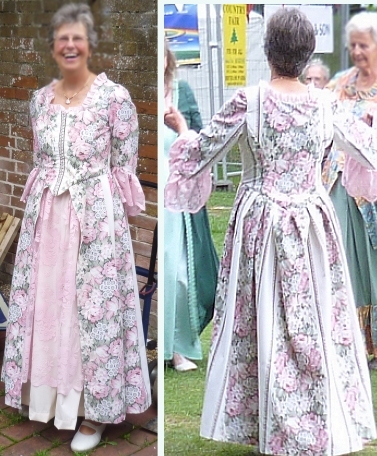
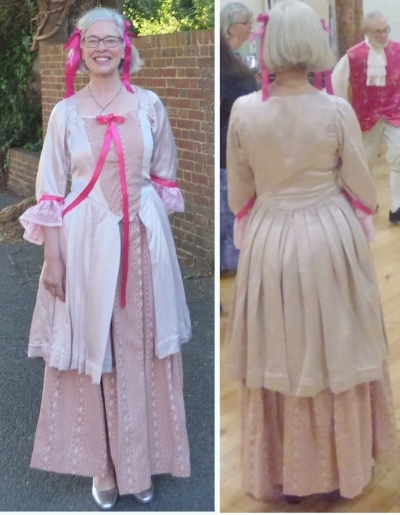
Club members, their friends and even complete strangers began offering lengths of fabric they had no use for. I also inherited leftover
fabric, thread, ribbon and lace.
The silk overdress and cotton underskirt pictured were made from donated cloth; and someone gave me half a mile of
the bright pink ribbon decorating it.
The short overdress reflects version A of the 3640 pattern but by this time I was mixing the pattern pieces from
one with another to achieve the desired result.
The bodice and sleeves are derived mostly from Simplicity pattern 4092. It also includes a pattern for
panniers (not yet used), and also advocates a back zip so needed adapting for a front bodice opening. Boning is used in the front, and sometimes in the back
of the bodice of the Playford dresses.
The blue costume pictured right, made from curtains, is decorated with blue ribbon from a seemingly endless reel
of redundant shop stock. I began using this ribbon last century for the girls in my international class and there are still yards and yards of it!
It should be noted that ladies always covered their hair in those times; at the very least there would be some ribbon or a scrap of lace. Somehow hats,
caps, or bonnets have not been taken up for use. I was reliably informed by an expert at the 17th Century Village that because we wore nothing on our heads
we would pass for "flash girls" as seen around the time of the Civil War.
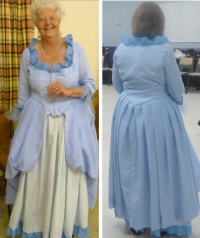

Due to my methods of procurement the quantity of any available fabric varies; and sleeves use up a lot of fabric. The sleeves on the
left are from Butterick 'Making History' pattern 3071 which has over and undersleeves. The undersleeve should match the underskirt. As the undersleeve is
not all visible the top half of this one is of different fabric thus solving a shortage.
The sleeves on the right from Simplicity pattern 4092 have
two smaller pieces to each sleeve, alleviating the need for one long piece. Also the same costume has a shorter overdress to overcome the problem of short curtains.
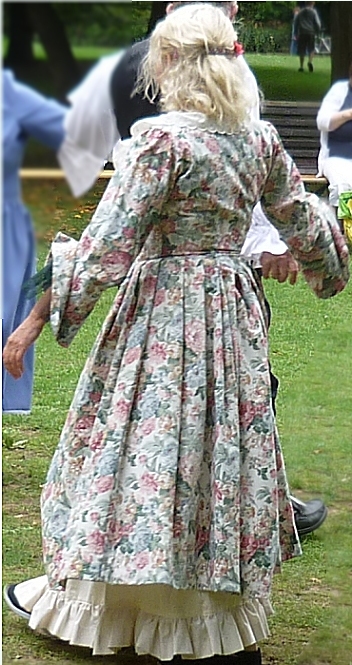
Someone presented me with a huge bag full of zips of mixed colour and length...I had never used them for costumes,
but as they were costfree and as my supply of hooks and eyes were running low I overcame my scruples so the costume on the right is zip fastened at the back.
The bodice is from the Simplicity pattern 5041; the skirts are fashioned to make the fullest use of a length of cloth and new unused curtains! All decorated
with more of the ubiquitous pink ribbon.
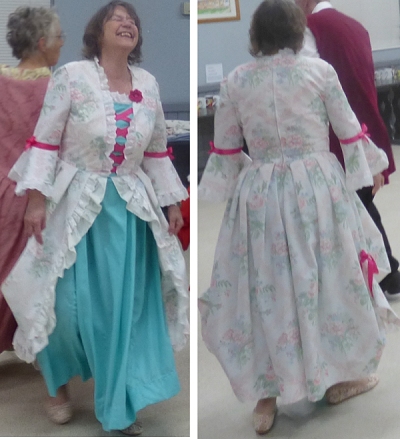

Men also wear costumes to Balls and for displays. Some wear full Playford regalia complete with wig, others in Regency mode often
with a colourful waistcoat.
Knee breeches are standard, those on the left are from Simplicity pattern 4923 from which I have also made the typical full-sleeve shirts and waistcoats;
also useful is the Burda pattern 2459. Most of the shirts were made out of curtain lining and lace collar and cuffs from net curtains.
Pictured on
the right is the Ted Pratt waistcoat as detailed on the waistcoat page


We enjoy many dances from sources such as the Apted and Fallibroome collections and the Regency costumes from that era are a cooler option to wear for dancing
on hot Summer days. Also, a lot less fabric is needed for each dress.
My first efforts at Regency style frocks were my own creation, no pattern, using
whatever was to hand; they are certainly easier to make than the Playford.
The lace around the flouce of this pink Regency dress was inherited handmade
lace; and that around the neckline was found in a selection of oddments passed on to me.
The main fabric of the dress was cut from an unused vallance
that had waited in vain for decades for the right bed.
The dress has a narrow length of tape, of the same fabric, channelled through the join of the bodice
and skirt and gathered in to tie as a bow at the back.
An antique Edwardian lace collar adorns this Regency style dress. Apparently the collar is 'pillow-lace', so
named as during construction it was pinned onto a pillow. It is also known as bobbin-lace; bobbins were the tools used by the lacemaker.
Pillow-lace
originated in Milan in the fourteenth century and the technique was spread across Europe often by refugees from religious wars. It has been made in some
parts of England for hundreds of years.
The fabric of this dress came from one single curtain - just enough for a Regency style dress. The Playford
costumes each require a pair of curtains at the very least.
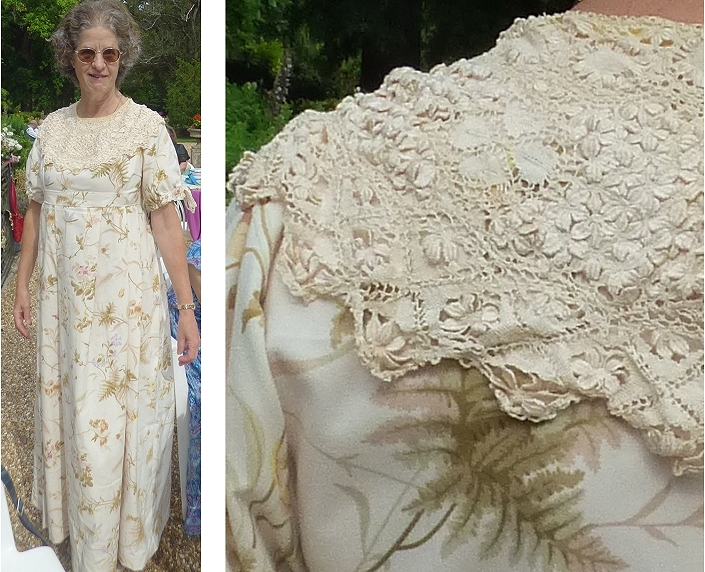
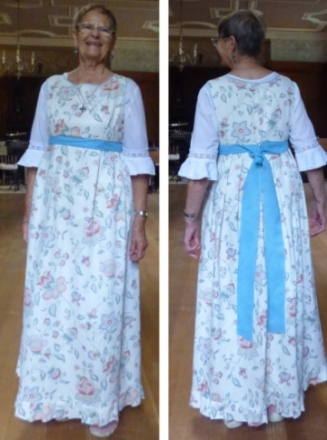
Again one single curtain was used to make up the Regency style pinafore dress with a flounce on the left. As there was not enough
fabric for sleeves, a blouse is worn underneath.
Several of our ladies with dress-making skills also make their own outfits (probably not from old
curtains!).
Two of our ladies, wearing the Regency dresses they created especially for our special 90th Year Summer Dance, are pictured on the right.
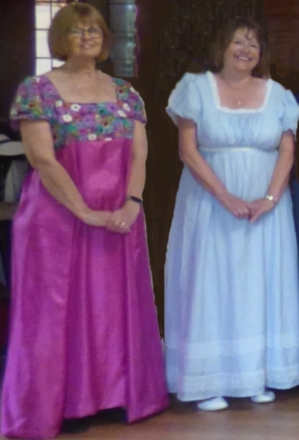
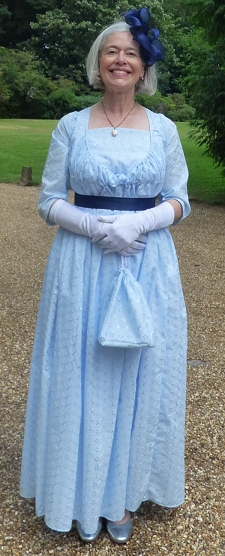
One of our dancers made her own Regency dress and passed the Simplicity pattern S8941 on to me, with a warning about the very low
neckline which she countered by inserting an under piece. To be accurate, simplicity is not a word that sits easily with this particular pattern.
An
extra three inches needed to be added on to achieve the modest neckline pictured on the right.
Although it's not a pattern I would recommend, it did give
some technical tips for achieving a neat join of bodice to skirt before gathering. However, it really uses too much fabric (in this case curtains),
especially for the gathered part of the bodice.
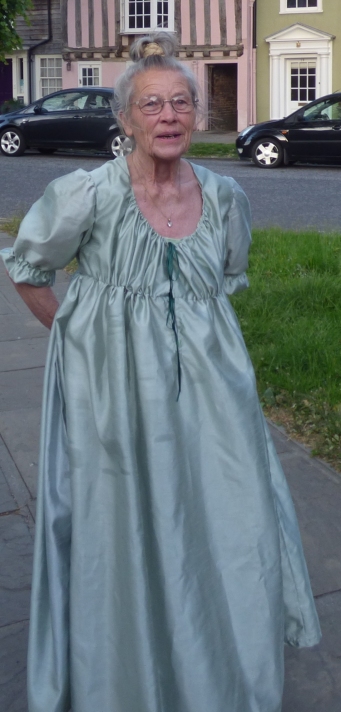
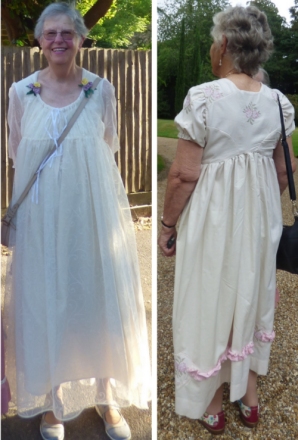
The best feature of the aforementioned pattern is the cut of the back; it does achieve the desired Regency look.
Both dresses here were also based on S8941, I followed the pattern fairly closely for the one on the left (still adding three inches to raise the neckline).
It was made from net curtains and curtain lining.
Modern living has also jettisoned table-cloths along with curtains.
From the same sources
I had a collection of embroidered table-cloths; one of which went towards the making of the Regency dress pictured on the right of the pair. It was constructed
using only the bodice lining section of the pattern and omitting the heavily gathered outer bodice section.
Top of Page
